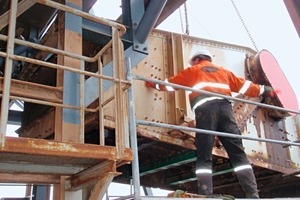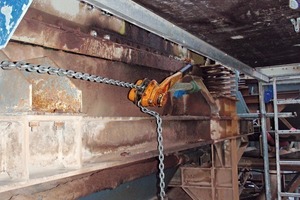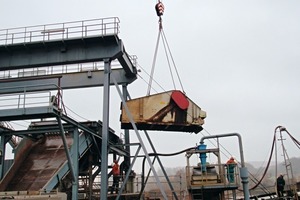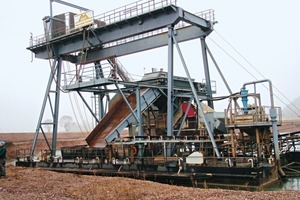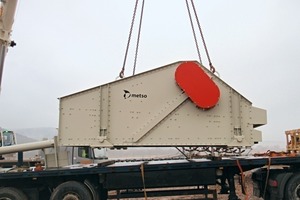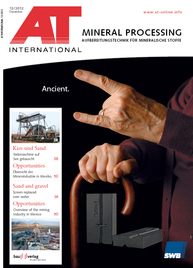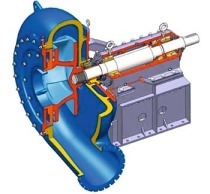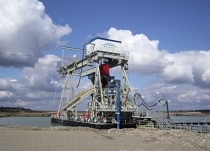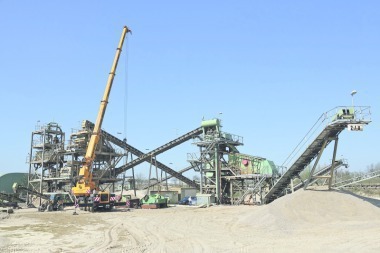Screen replaced over water
Fambach sand and gravel deposit, a site operated by MKW (Mitteldeutsche Hartstein-, Kies- und Mischwerke GmbH – an aggregate supplies), lies in an eroded basin in the Werra Valley, forming part of the south-western variegated sandstone foreland of the Thuringian Forest. The gravel works at Fambach has been producing aggregate for concrete engineering and road construction since 1997. The raw gravel is extracted with a 200-t floating dredger with a grab volume of six cubic metres. The dredger is equipped with an extraction control system, which operates on the basis of GPS, depth sonar and echo sounding and represents the state of the art in underwater extraction. From the raw gravel pile, the material is transported by means of tunnel feeders and belt conveyors to the processing plant. The certified products and capacities have proven effective especially in tunnel and motorway construction projects along the route of the A 71 motorway. Since the outset, a H2PP screen originally supplied by GFA has been in operation at MKW’s Fambach site. Metso Minerals recently sent the machine into well-earned retirement following 15 years’ of work at the dredging lake. Prior to this, arrangements had been made for the replacement of this classic linear-motion vibrating screen with an identical machine.
1 A smooth operator
After long years in use, exposed to harsh conditions, the screen needed replacing. Site manager Dennis Krug and his engineering manager Dipl.-Ing. Thomas Münzner went about the task of acquiring a new screen that had to meet specific requirements at the site. Some of these requirements were derived from the fact that the new primary screen would be used on the same freely moving floating dredger (a pontoon) and constantly exposed to the wet. The around 450 t/h material was to be sized directly on the lake. The grab of the floating dredge dives daily to the bottom of the lake and loads the wet raw material into the hopper. From here the material is metered to the screen, which performs a straight separation into oversize/undersize. The typical gravel fraction is then conveyed to the operation’s raw gravel pile. The total dewatered 2/32 material is sent to the different grading screens. On the lower deck of the double-deck screen and over the screen pan, dewatering is performed by means of a cyclone, which recovers any fine sand up to 2 mm. Via a Metso ESU-screen, the material is then transferred back to the belt. At the site, the material is processed so that later at the plant it can be fed direct to its purpose. For a screen operating over a lake, 15 years is a grand age, as, unlike machines working on dry land, it is exposed to very specific laws of nature. Owing to the exterior influences and processing of the water-sand mix, the side walls became thinner and weaker over the years, impairing stability.
At the Fambach site, it was soon agreed that the old GFA screen should be replaced with a machine of identical design (Fig. 1). As GFA’s legal successor, Metso had a good chance of getting the order, as the GFA screen had performed so efficiently on a daily basis for such a long time. In January 2012, Metso was awarded the contract and within just seven weeks – in line with the agreed delivery term – a replacement machine of the same type was produced.
2 Lifted out and refitted
At the customer request, the screen was replaced with a new machine that was completely true to the original, although the wear pattern of the long years of use was taken into consideration, and for that reason all cross-members were specially rubberized. The entire replacement was completed within just three days (Fig. 2). During installation, one other company was called in to move the grab out of the danger zone. To take advantage of this opportunity, the entire hydraulics was overhauled at the same time.
For the purpose of installation, the dredge was pulled to the edge of the lake with a cable winch and fixed there. In addition, a 140 t crane with a suitably long boom was needed to pick up the screen at the right points and lift it from the pontoon (Fig. 3). The screen was not fixed to the crane vertically, but with chain hoists below the pendulum – a fixture below the hopper. In addition, the rear panel of the old screen had to be removed to enable the now aging screen to be pulled horizontally half a metre over the steel structure of the pontoon as if on a sledge. The new screen was then installed precisely in the opposite way (Fig. 4).
Since its installation, the new H2PP screen stands above the screen pan. An angle plate designed as spray protection could only be bolted on when the screen was in its final position. This way, any danger that the all-round plate would be dented by the crane in case of the slightest deviation could be eliminated. The biggest effort was required for fixing the spring elements (each consisting of the spring and spring upper/lower part). These had to be positioned exactly on the steel members and fixed precisely with bolts. Adjustment, bolting and tightening with appropriate nuts from the inside took longer than the actual moving of the screen. Only then could the rear panel be fixed to the screen.
Finally, in Fambach, on special request, the double motor console was replaced. As the screen is a linear-motion vibrating screen, there are two drives. The electronically braking electric motor uses a universal joint shaft to drive the unbalance shaft with the self-aligning roller bearing and unbalance weight.
3 Renaissance of classic machines
Over the years, interface management has established itself as a key criterion for replacement components. Operations managers and operatives very often swear by the machines they have been using to successfully produce their products to the very last second.
The manufacturer taken over by Metso, as durable and rugged machines that were both solid and reliable. A classic screen re-issued by Metso is always state of the art (Fig. 5). Justus Mische, Sales Manager Sand & Gravel/Quarry Operations at Metso Minerals, regards the “patching up” of older machines as uneconomical but a re-release or general overhaul as indispensable in the case of many older machines. “In our existing portfolio of screens, particularly here in Germany, we have extensive experience with our 1:1 classic screens and can adapt these flexibly and individually to the needs of our customers. Here the focus is on a balanced ratio of investment and operating costs per tonne. It is similar sort of the thing with the size and organization of stock warehousing – here many manufacturers or replacement part suppliers try to make savings in the wrong place.” All Metso screens can be optionally equipped with original Metso polyurethane, rubber or wire screen surface changeover system.

